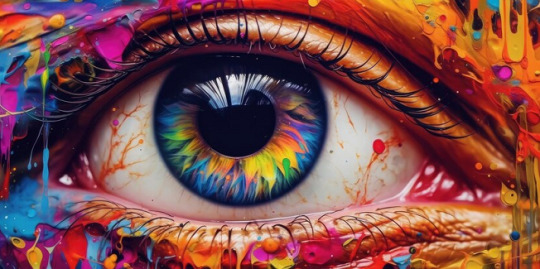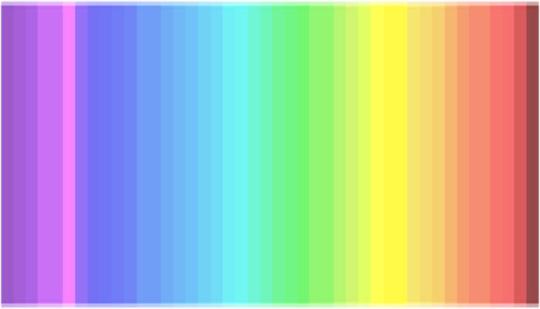#Color perception
Explore tagged Tumblr posts
Text
We ask your questions so you don’t have to! Submit your questions to have them posted anonymously as polls.
#polls#incognito polls#anonymous#tumblr polls#tumblr users#questions#miscellaneous polls#submitted dec 22#color#color perception#senses
930 notes
·
View notes
Text

Theory of Colours, Plate IX, 1810 by Goethe
#color theory#color phenomena#color perception#color#colour theory#colour phenomena#colour perception#colour#goethe#weimar#germany#Zur Farbenlehre#Theory of Colours
3 notes
·
View notes
Text
The Science of Seeing Colors: Why Everyone’s Color Experience is Different

Colors have an undeniable impact on our lives, influencing emotions, decisions, and even the way we interact with the world. Have you ever paused to wonder if the vibrant scarlet you see is the same red someone else perceives? Welcome to the fascinating realm of color perception, where the science of sight meets the art of individuality. Today, we're diving into why and how different people might see colors differently.
The Science Behind Seeing Color
At its core, color perception is a dance between light, our eyes, and our brains. The eyes capture light, which is then interpreted by the brain, forming the colors we see. But here's where it gets interesting—what we actually perceive can vary widely from person to person.
Cones and Color Vision: The human eye contains three types of cone cells, each sensitive to different wavelengths of light (red, green, and blue). Variations in these cells can lead to different color perceptions.
Color Blindness: This isn’t just about seeing the world in black and white. People with color vision deficiencies might find it challenging to distinguish between certain colors, often red and green.
Factors Influencing Color Perception
Genetics: Our genes play a significant role in determining how we perceive color. Genetic differences can lead to variations in cone cell distribution, affecting how we see color.
Lighting Conditions: The lighting around us can dramatically alter our color perception. A shirt might look navy under fluorescent lights but seem almost black in dim lighting.
Neurological Factors: Our brains process colors differently, too. This is why some people claim certain colors have a "warmer" or "cooler" tone than others might describe.
Cultural Influences: Culture shapes how we interpret colors. For instance, white is often associated with purity in Western societies, while it might represent mourning in others.
Age and Eye Health: As we age, our lenses can yellow, which might affect the way we perceive certain colors. Additionally, conditions like cataracts can influence color vision.
Curious Cases in Color Perception
Tetrachromacy: A rare occurrence where individuals possess a fourth type of cone cell, potentially allowing them to see up to 100 million colors—a whole spectrum we can't even imagine!
Synesthesia: Some people experience synesthesia, where stimulation of one sensory pathway leads to automatic, involuntary experiences in a second pathway. This can result in seeing specific colors when hearing certain sounds.
Embracing Colorful Diversity
Understanding that we all see colors a bit differently is both intriguing and useful. It reminds us of the subjective nature of perception and can foster greater empathy and communication in design, marketing, and even daily interactions. So, next time you and a friend disagree on whether a dress is blue or black, embrace the diversity of perception and enjoy the kaleidoscope of perspectives!
In a world brimming with color, isn't it wonderful to know that we each have a unique lens through which we view it? Whether you're an artist seeking inspiration or just someone admiring a sunset, the variations in color perception add an extra layer of beauty to the world around us. Keep seeing the world your way—after all, that's what makes it truly vibrant!
Go To How People May See Differences in Color
#color perception#human eye color vision#cone cells and color vision#color blindness types#genetic differences in color vision#tetrachromacy#synesthesia and color#color vision deficiency#cultural color interpretations#lighting effects on color#neurological factors in color perception#age and eye health impact on color#unique color experiences#individual differences in seeing color#visual perception of color
3 notes
·
View notes
Text
The cones in our eyes are broken down into three different varieties, call them L, M, and S, each of which is most sensitive to a different wavelength of light. So each color that we perceive is created by different stimulation ratios of the three kinds of cones. But their sensitivity bands overlap somewhat, particularly between the L and M cones, corresponding to red and green sensitivity. This experiment uses very precise lasers to target ONLY the M, or green-sensitive cones. They call this color “olo”, or 0 1 0, representing the cone stimulation map . I would call it “super-green”, which makes a monochromatic green laser beam look comparatively washed out.
Using this technique, super-saturated colors could conceivably be perceived in the longer wavelengths, such as yellow, orange, and some shades of red.
Note that “Super-green” is not a color that would ever occur naturally. But it can exist in the mind.
From the comments section:
I once was stopped by a State Trooper because I didn't have my lights on. I explained that I have such good night vision, that this used to be a problem when I was first learning to drive. I also mentioned that I have colored night vision. I went home and started telling my 16-year-old son the story, but I only got as far as "colored night vision", when he said, "But Mom, doesn't everyone have colored night vision?" I explained that, no, this is rare. I recently found out that women who have colored night vision usually have sons who are color blind. So my son is even more rare.
1 note
·
View note
Photo

How Do Cows See Color?
#cows#cow#color vision#animal vision#animal behavior#bovine#color perception#livestock#animal science#midjourney#ai
0 notes
Text
Lucifer: *enters the hotel*
Alastor: I cast vicious mockery 😈
An animation my sis and I made for fun
Music is Perception Check by Tom Cardy.
#hazbin hotel alastor#Hazbin hotel#Hazbin hotel Lucifer#vivziepop#Hazbin hotel fanart#Alastor#Lucifer#Perception check#“you're much shorter in real life”#Alastor has no mercy if you're under 5“2 lol#I did: the storyboard; artworks and animation#And my sis did: the coloring; animation as well and the compositing#Team work makes the dream work lol
74K notes
·
View notes
Photo
I count 35!
Fun fact: a biological difference between men and women is that women and girls have better color perception than males. Women provide more correct answers in color tests (especially for red and green) and take less time to answer. We can see more shades of color than males.

25% of the people have a 4th cone and see colors as they are
Given the sudden interest for the color of dresses and vision, here some of the fascinating findings we did recently.
The color nuances we see depend on the number and distribution of cones (=color receptors) in our eye. You can check this rainbow: how many color nuances do you count?
You see less than 20 color nuances: you are a dichromats, like dogs, which means you have 2 types of cones only. You are likely to wear black, beige, and blue. 25% of the population is dichromat.
You see between 20 and 32 color nuances: you are a trichromat, you have 3 types of cones (in the purple/blue, green and red area). You enjoy different colors as you can appreciate them. 50% of the population is trichromat.
You see between 33 and 39 colors: you are a tetrachromat, like bees, and have 4 types of cones (in the purple/blue, green, red plus yellow area). You are irritated by yellow, so this color will be nowhere to be found in your wardrobe. 25% of the population is tetrachromat.
You see more than 39 color nuances: come on, you are making up things! there are only 39 different colors in the test and probably only 35 are properly translated by your computer screen anyway :)
It is highly probable that people who have an additional 4th cone do not get tricked by blue/black or white/gold dresses, no matter the background light ;)
(x)
379K notes
·
View notes
Text
The X-Rite Color Challenge
I tried to reblog this from somebody else, but instead the page refreshed and the post was lost.
The X-Rite Color Challenge quiz by Pantone is a much simpler, more casual version of a genuine diagnostic color perception test. I took it and got a 0, the perfect score. It's interesting; give it a shot. There's no obnoxious signup or e-mail required.
I found that I was not able to directly discern the order of the gradations, but that I could easily spot discrepancies when one or more tiles was out of order. My confidence mode was "If it doesn't look wrong, it's right." That turned out to carry me all the way to 0!
The aquamarine-to-lavender spectrum (No. 3) was the hardest for me to resolve color breadth on, when the spectrum was still in its disorganized form, so even though I sorted it perfectly this probably represents the region of the spectrum where my discernment is lowest.
I took my time on this; probably spent around 5 minutes on it. If I'd gone faster I would definitely have made mistakes, because I did a lot of A/B testing to verify that many of my null reads were in fact the absences of errors.
The results page notes:
Did you know that your score on this test is influenced by the lighting around you, the background colors at your desk area, your level of tiredness, your gender, and even your age?
For me, it is early in my day (so I am well-rested), dark outside, the background behind my computer is black (an inactive monitor screen), and there is moderate-low room lighting in the "warm" temperature range.
According to their results, the "worst score for my gender" is "696969696," while the "best score for my gender" is "-696969696." Lol...
#Pantone#X-Rite#X-Rite Color Challenge#Color test#Vision test#Color perception#Given that my gender is “none” but the only gender options were sex binaries; a meme error is only fitting.
0 notes
Text

#art#digitalart#psychology#visual illusion#color assimilation illusion#brain science#color perception#ai#aiart#optical illusion#perception
1 note
·
View note
Text

#ai#brain science#aiart#perception#psychology#visual illusion#optical illusion#digitalart#color perception#color assimilation illusion#art
0 notes
Text

#color perception#aiart#visual illusion#art#ai#digitalart#optical illusion#psychology#brain science#color assimilation illusion#perception
0 notes
Text
That feeling when your "adult" relatives are actually cool now that you are also an adult.
I’m in the middle of writing a blog post about how I use internal dialogue techniques to process my trauma, and compensate for my weird behaviors.
I fell down the rabbit hole of the cognitive perception of color.
This is cool.
But what tripped me out was seeing my grandmother’s name on some of the more influential studies that shows that language affects color perception.
Has anybody else discovered something about parental figures/older family members that you remember finding boring as a kid, but is actually really cool?
#writers on tumblr#writing#cognitive psychology#cognitive perception of color#grandparents are cool actually#random#reading research#why am i like this#color perception#blogging#writblr#personal post#science
1 note
·
View note
Text
the only real gender binary i'm aware of is
sees blood on leaves
and
sees whether something besides the leaves is moving
#i'm still genderfluid#gender theory#shitposts#cw blood mention#color perception#color blindness#shrimp gender
1 note
·
View note
Text
The biology of color perception and the "grayscale" trend. Fascinating!
0 notes
Text
This is correct. (link to a 2015 Johns Hopkins Univ. Newsletter since the original Nature article from 2014 is paywalled)
Periodic buzzkill reminder from a scientist that shrimp cannot see more colors than we can
29 notes
·
View notes